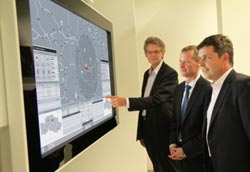Optimizing Rail Operations with a Big Touchscreen

<br>
The display, whose diagonal dimension is 1.5 meters, can show all of the data and facts that are necessary for decision-making. At the heart of this solution is software from Siemens that uses mathematical optimization algorithms to network systems that were previously unconnected, such as maintenance and train disposition.
Until now, the individual departments of rail operators have mostly responded to disruptions independently from one another, because they didn't have any information about the situation outside of their own area of responsibility. With the new coordinated approach, trains could be rerouted and stretches of tracks closed in line with optimized criteria.
This information could also be fed to a “Train delay app” that would provide rail travelers with current information, as was reported in the research magazine “Pictures of the Future”.
This IT solution from Siemens is the first system to collect all of the data resources and information relevant for decision-making from the areas that were previously separate. The current situation is clearly displayed on a multitouch table, where everyone involved can work simultaneously. When there is a disruption in rail traffic – for example, it becomes necessary to close a stretch of track – traffic controllers and those responsible for maintenance need a plan of action quickly. The two groups have different priorities and require different information in order to make their decisions.
Traffic controllers have to avoid costly delays and ensure that as many people as possible are transported. To this end, they have to know where and how many trains and passengers will be affected. In addition, they need information about which tracks can be used for rerouting. Maintenance personnel, on the other hand, need information about the nature of the disruption, whether a replacement train will be needed, and how quickly technicians equipped with the necessary parts will be able to get to the site.
The objective is the optimal use of all the equipment. Presently, because the systems aren't interconnected, those involved only see how their decisions affect their own area of responsibility.
The algorithm from Siemens can find the best scenario for rail operators. The program works out an optimal solution based on the data and also considers constraining factors such as contractual penalties for delays. The program is operated using a 60-inch multitouch table – in other words, it's a bit like a giant smartphone. The touch screen display can process up to 32 operations simultaneously. The responsible individuals can run through their ideas together in order to quickly find the best approach for everybody
Media Contact
More Information:
http://www.siemens.com/innovationnewsAll latest news from the category: Information Technology
Here you can find a summary of innovations in the fields of information and data processing and up-to-date developments on IT equipment and hardware.
This area covers topics such as IT services, IT architectures, IT management and telecommunications.
Newest articles

High-energy-density aqueous battery based on halogen multi-electron transfer
Traditional non-aqueous lithium-ion batteries have a high energy density, but their safety is compromised due to the flammable organic electrolytes they utilize. Aqueous batteries use water as the solvent for…

First-ever combined heart pump and pig kidney transplant
…gives new hope to patient with terminal illness. Surgeons at NYU Langone Health performed the first-ever combined mechanical heart pump and gene-edited pig kidney transplant surgery in a 54-year-old woman…

Biophysics: Testing how well biomarkers work
LMU researchers have developed a method to determine how reliably target proteins can be labeled using super-resolution fluorescence microscopy. Modern microscopy techniques make it possible to examine the inner workings…





















